Investigation of Cultural Eco-Technology in Iranian Traditional Architecture: The Way of Achieving A Comprehensive View Point Regarding Contemporary Architecture of Iran
Mahmood Feizabadi 1 * , Nazanin Rezaei 1 and Farzaneh Raisianzadeh 1
DOI: http://dx.doi.org/10.12944/CWE.11.2.19
After industrial revolution many of visionaries deal with technology in underdeveloped communities; but dealing with technology did not lead to preserving identity and culture in cities and caused unconsidered deployment of technology for response to construction needs and made environmental damages. Today, the lack of attention to the cultural aspects of the architecture in developing countries is become a common issue .This despite the fact that many of these countries, such as Iran, have rich culture and glorious history in art, engineering and architecture. So, extensive study on Iranian Traditional architecture and its technologic solutions to solve ecological issues in a cultural context have been carried out. This paper aims to find how technology and ecology were influenced by Iranian culture and how come together in contemporary architecture. This investigation was carried out based on library and field studies. Here, the concept of sustainability and position of ecology, technology and culture in it, Relationship between culture and eco-tech architecture in developing countries will be explained. Then, Iranian traditional architecture and its eco-technologic solutions in a cultural context will be discussed.
Copy the following to cite this article:
Feizabadi M, Rezaei N, Raisianzadeh F. Investigation of Cultural Eco-Technology in Iranian Traditional Architecture: The Way of Achieving A Comprehensive View Point Regarding Contemporary Architecture of Iran. Curr World Environ 2016;11(2) DOI:http://dx.doi.org/10.12944/CWE.11.2.19
Copy the following to cite this URL:
Feizabadi M, Rezaei N, Raisianzadeh F. Investigation of Cultural Eco-Technology in Iranian Traditional Architecture: The Way of Achieving A Comprehensive View Point Regarding Contemporary Architecture of Iran. Curr World Environ 2016;11(2). Available from: http://www.cwejournal.org?p=906/
Download article (pdf) Citation Manager Publish History
Select type of program for download
| Endnote EndNote format (Mac & Win) | |
| Reference Manager Ris format (Win only) | |
| Procite Ris format (Win only) | |
| Medlars Format | |
| RefWorks Format RefWorks format (Mac & Win) | |
| BibTex Format BibTex format (Mac & Win) |
Article Publishing History
| Received: | 2016-03-01 |
|---|---|
| Accepted: | 2016-05-07 |
Introduction
The concept of Eco-Technology was raised in 1990 and under the influence of the 'Our Common Future’ report. In this report that published in 1987, sustainable development was specified as ‘‘development that meets the needs of the present without compromising the ability of future generations to meet their own needs’’.1 Since the presentation of Our Common Future, ‘sustainable development’ is a leading concept in policies related to the environment.2 According to Straskraba's definition, Eco-technology is the use of technological means for ecosystem management based on deep understanding of principles on which natural ecological systems are built and on the transfer of such principles into ecosystem management in a way to minimize the costs of the measures and their harm to the global environment.3
Recently it has been discussed that culture has a separate, distinct, and integral role in sustainable development.4,5,6 Additionally, study on different communities and their ecological history demonstrate that concepts of 'sustainable development' and 'eco-technology' are influenced by culture. Evidence can be found in some references in which sustainable development is considered to consist of ecological, economic, and sociocultural dimensions, or ‘pillars’.7 8 Steele9 expresses that sustainability embraces eight issues: resource equity, embodied energy, global community, economics, renewability, traditional wisdom, institutional change and technology. Ecological concerns and the environmental dimension have been discussed more than other dimensions. Nevertheless, the social dimension and institutional aspects are considered as important issue to achieve environmental aims regarding to sustainable development.10
According to concept of sustainable development, sustainability has led to a revision of the way we view tradition or culture. It is accepted that culture has something to teach us, that 'local' architecture grew out of many trial-and-error attempts to deal with natural phenomena, and should be respected as a repository of wisdom.9
Over the past decades, sustainable development has become an ever more comprehensive framework.11 The concept of sustainable development can be considered as a demand for sustaining ‘qualities of life’.12 So, this concept is deemed as a science inclusive of values and responsibilities.13 Hay14 noted that this includes giving attention to the way we view ourselves and the world (philosophy), what forms of improvement appear to be most appropriate (development( and how to motivate and help direct us to get there (leadership). Accordingly, Culture has a considerable effect on the way people think and act, rooted in underlying values which express what people consider as worthwhile.2
Architecture in Greater Iran has a continuous history from at least 5000 BCE to the present, with characteristic examples distributed over a vast area from Syria to North India and the borders of China. Iranian traditional architecture vary from peasant huts to tea houses, and garden pavilions to some of the most majestic structures the world has ever seen.15 In the past, Iranian people considered culture as the main factor of their decision making and every problem solving. This way of thinking has led them to an integral architecture design in which ecologic, technologic and cultural issues has been solved simultaneously.16
Scientific exploring in references shows that principles of Iranian traditional architecture are approximately compatible with sustainable development fundamentals.17 According to studies on cultural heritages of Isfahan, the essence of Iranian traditional architecture covers environmental, social and economic issues and extensive study on its process can explain how urban forms, in particular contexts, respond to sustainable development of Iranian old cities.18, 19, 20, 21 Despite of all, nowadays we see that ecologic issues have not conformity with available technologies and both of them are not related to context and local culture.
State the Problem
After industrial revolution and its damaging impact on cities's identity – especially in underdeveloped communities- many of visionaries deal with technology. This decision was made without paying attention to the issues such as increasing need to housing and building and stay on the education system agenda. But dealing with technology did not lead to preserving identity and culture in cities and caused unconsidered deployment of technology for response to construction needs.
According to Eco-tech attitude, incorporation of technology and ecology can cause creating buildings and cities with minimum environmental damages.22 But cultural issues have not considered in this viewpoint. Therefore, Theory of Cultural Eco-Technology aims to find eco-technology roots In Iranian traditional architecture in order to achieve a comprehensive viewpoint regarding contemporary architecture that incorporates technology, ecology and national culture.
Architecture is a social subject which is in close contact with culture.23 In many countries, technology is considered against the culture and served as a deteriorating agent for architecture, but today we know that architecture is not able to achieve its goals without help of technology. So we should use technology as a tool to produce architecture in order to quench our needs for improving country's culture. To conclude, cultural eco-technology is a very helpful hypothesis in our country's architectural principles in education system of many countries, technology is considered against culture and as a culture and identity destructive factor. The main questions are as follow:
- How do technology and ecology are influenced by culture in Iranian traditional architecture?
- How can technology, ecology and culture come together in contemporary architecture of Iran?
Research hypothesis is that Iranian traditional architecture could make mega architectures in which ecology, technology and culture come together. Additionally, authors express that study on Iranian traditional architecture and their culture can illuminate the way for achieving cultural eco-tech architecture in present and future.
Research Method
The meanings of cultural Eco-Technology can be explored through concept analysis. In our case, this analysis would imply thorough theoretical investigation of the concepts of culture, Ecology, Technology, sustainability, and their relationships. According to research background, sustainable development has four pillars: Ecology, Economy, Society and Culture.6,7,8,9,10 As shown below (Fig.1), Technology as an intermediate indicator helps us in order to manage ecological issues in a way that minimize harm to the global environment.3 Eco-technology was utilized in different ways in different cultural contexts. In the other words, eco-technology should be under the influence of culture.9 So, cultural eco-technology will be the necessity for achieving sustainable development in different countries.
Research Structure consists of three main issue explanations including (Fig.2):
- Concept of Sustainability: Position of Culture, Ecology and Technology; This section discussed about cultural sustainability dimensions, and eco-technological means to manage heritages in present.
- Relationship Between Culture and Eco-Tech Architecture in Developing Countries; Introduce and discuss some well-known architecture projects in developing countries that solve ecological problems with technologies that reflect social, historical and cultural indicators
- Iranian Traditional Architecture: Eco-technology in a Cultural Context; This section explain how cultural indicators in Iranian life style influence architecture and use of technologies for ecological goals. This paper aims to demonstrate that this kind of architecture could be deemed as a panacea for contemporary architecture in Iran.
Concept of Sustainability: Position of Culture and Ecology
Although the concept of sustainability has been criticized frequently, but covers wide contexts and meanings and is broader than we expect. Increasing environmental and sociocultural challenges, has led to attract attention to concept of sustainability in field of science and policy.24 In the policy field, culture has been known as an aspect of social sustainability and occasionally even as a pillar of its own. The interrelationship between culture and sustainable development was discussed during the UNESCO25 Decade of Culture and Development (1988–1997) and other international policy documents and conventions. However, the relationship between culture and ecology has not been expressed clearly in these documents. But there have been other policy initiatives to introduce culture as the dimension of sustainable development at the international, national, regional, and even local levels.6,26,2,28,29,30 Throsby 28 subsequently explored the linkages between ecological and cultural sustainability.
As shown in Fig.3, Soini and Birkeland 6 suggested a chart in which cultural sustainability is organized around seven storylines: heritage, vitality, economic viability, diversity, locality, ecocultural resilience, and eco-cultural civilization. These storylines are partly interlinked, but they can be different regarding to context. These storylines are expressed in four political and ideological contexts, conservative, neoliberal, communitarian, and environmentalist. This chart can explain position of culture, ecology and technology.
Technology may provide efficient means for the preservation of cultural heritage, such as concrete conservation work,20 but it also involves risks in terms of destroying the historical layers of sites.31 Although the heritage story line represents expert knowledge and a top-down cultural policy.18 it has also been noted that local, ecological knowledge constitutes an important resource for the protection of tangible cultural heritage32 and for livelihood practices.33
Relationship Between Culture and Eco-Tech Architecture
The high-tech architecture movement epitomized by main buildings such as Paris's Centre Georges Pompidou (1977) and London's Lloyd's Building (1986) has undergone a delicate but sensible transformation. While courage masterpieces of structural engineering however mark recent projects by the architects who built the earliest examples, a new generation has expanded the terminology of this architectonic language, and evolved the architecture with different goals. The most important of these objectives is to create a sustainable architecture.22
Renzo Piano in designing Jean- Marie Tijibao Cultural Center mixes local systems and materials with Western experiment and methods. It pays homage to the well- defined Kanak culture by regarding its traditions and not suggesting a trivial historic renovation or a completely foreign model.34 Likewise in developing countries architects like Charls Corea, Balkrishna Doshi and Hassan Fathy could combine form and material with their country's tradition and lodging and create original works.35 Hassan Fathy, who purposely set out to conclude a cultural based alternative to the 'International Style' for Egypt, began by manage extensive research into domestic prototypes to discover the reasons for their climatic effectiveness in the lack of mechanical systems.9
Another Architect, Rasem Jamal Badran (born 1945 in Jerusalem), a Jordanian architect whose works are based on a methodological approach in describing Architecture as a continuous discussion between contemporary needs and historical inherited cultural values.36 One of his famous projects is Riyadh Justice Palace in which he elucidate continuous questions about the appropriateness of natural environmental system in this region and the interpretation of a distinctive historical style. Badran found scale to be a key standard of the earlier architecture of the district, combined with environmental considerations related to the extremely hot, arid climate.9
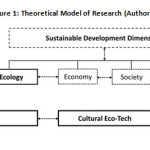 |
|
Dezful Cultural center (1987-1993) is one of the modern architectural masterpieces inspired by Dezful traditional architect with a universal perception of Farhad Ahmadi, the great Iranian engineer. The structure of the complex represents the human movement from soil into heaven. It is considered as an outstanding pattern for the students of all over the country due to its extremely impressive design. Also, it has won several numbers of international prizes in Norway architectural festival. Two cinema halls, a restaurant, a teahouse, a coffee shop, a landscaped courtyard, visual arts and some galleries are the other parts of this admirable cultural center.
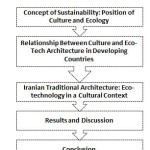 |
|
Structure of Dezful Cultural Center is based on a spiral path started with flowing water from a square courtyard, achieving to an octagon yard in the depth of the earth by a rotation inside a transparent inverted cone, in order to depict the story of mortal man from the world to the paradise by this amphibology. Plan of the building has been obtained from processing an arabesque in three dimensions and four wind towers around this paradise courtyard which amplify kind of looking to the sky.37
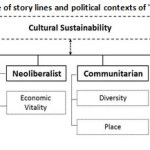 |
|
Cal-Earth Institute38 noted "The global need for housing includes 17 million refugees and displaced persons – victims of natural disasters and wars. Iranian architect Nader Khalili believes that this need can be addressed only by using the potential of earth construction. After extensive research into vernacular earth building methods in Iran, followed by detailed prototyping, he has developed the sandbag or ‘super adobe’ system. The concept allows people to build their own shelter simply by packing whatever earth they find in their location into sandbags, which are then stacked into dome forms, held together by barbed wire. The shelters are structurally strong – able to resist earthquakes, fires, floods and hurricanes. They are extremely quick, easy and cheap to build. They can be made into permanent structures by rendering them with external plaster and adding any necessary ancillary spaces. They are sustainable in terms of energy, using only sun, shade and gravity. They are adaptable in terms of size, material and configuration, and the system can also be used to build roads and other infrastructure.39 These shelters focus on the economic empowerment of people by participation in the creation of their own homes and communities to create sustainable developments that integrate traditional building materials with modern materials and technology, providing comfortable living spaces acceptable to modern safety standards. The prototype is a symbiosis of tradition and technology. It employs vernacular forms, integrating loadbearing and tensile structures, but provides a remarkable degree of strength and durability for this type of construction, which is traditionally weak and fragile, through a composite system of sandbags and barbed wire".38
The eco-cultural issues and technologic strategies of mentioned projects are summarized in table 1. This table shows how ecologic problems and their technological solutions are influenced by their regional culture.
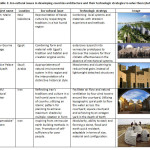 |
|
![Fig.4: Adaptation of principles of Sustainable architecture and Traditional architecture of Iran [17]](http://www.cwejournal.org/wp-content/uploads/2016/05/Vol11_No2_Inve_Mahm_Fig4-150x150.jpg) |
|
Iranian Traditional Architecture: Eco-technology in a Cultural Context
According to Pirnia40 Iranian architecture is based on several fundamental characteristics. These are:
- Introversion• structure• homogeneous proportions• anthropomorphism• symmetry and anti-symmetry• Minimalism
Study on concept of sustainable development and Iranian traditional architecture demonstrates that all of five principles of traditional architecture of Iran were adapted with principles of sustainable architecture.
The principles of "Autonomy", "Structure and Modulation"and "Purposefulness" included in the category of economy, while the principles of "Introversion" and "Autonomy" were reflected by the environment and the principles of "Human-Conformity" and "Introversion" were included in the social issue category. Introversion can be considered as an environmental factor that has shaped toward a courtyard inside of building (effect of the environment). Otherwise, this factor has been originated from Iranians belief as a sign of sanctity of personal life and prominence of the privacy, veil and hierarchy in the Iranian architecture (community effect) and is not specific to a particular climate or function. Autonomy means independence, which primarily refers to the economy and secondly demonstrates an environmental friendly feature of the traditional building and as well as the use of local materials. This demonstrates that Iranian architects were always aware of the environmental impact of the buildings and have always accounted for the economic features of a building in designing the architectural space to be proportional to human dimension and its personal and social activities17 (Fig.4).
The basic clearly trait of Iran architecture is that all of them have been derived from one worldview and way of thinking that mainly focuses on spiritual images of life without negligence of material aspects.41 Life style is the various ways and styles of living for using the maximum of environment potentially. It seems that the culture specifications according to people's worldview and their environment characteristics, which help to adapt and regard the nature laws. The most important need for life in desert is to have personal particularities in adaptability with natural environment as much as which of social. Everyday life of people in this region:
- Have the working mentality for to failure the hard state and transforming the environmental limits into possibility;
- To be enough to what the nature gives him though little;
- foresight, a characteristic inflicted by limits of hard nature for gaining one’s living that ensure him and future descendant without fright of future.
These three characters help to sustain the life at least in the good conditions for the persons. The effort must continue the descendant by descendant. This method aids the people to know better their needs and environmental potentials. The development and the political structures with citizen participation, which sustain it, is clearly an essential requirement of local and regional government in a sustainable world.16
Iranian traditional architecture in each region and climate possess specified features that influenced by cultural context. These cultural indicators are expressed in different forms of architecture and often were derived from the everyday life style of people to create human-based spaces. Contentment, diligence, providence, privacy, self-respect, generosity and spirituality are some cultural features of Iranian life style that had significant role in formation of traditional architecture (Fig.5)
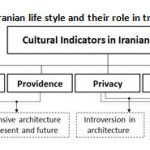 |
|
Ahmadkhani Maleki16 expressed that "Residential architecture of these regions is an expressive sample of ecological architecture. Old architecture in hot and dry region is in accordance with region and regional factors such as desired and undesired winds, humidity, sun, etc. Planning each of the full and empty spaces like court yard with tall and shading walls, enclosed spaces, porches, rooms in different directions, corner rooms with wind-catcher and pond, basement and roof is for special hours of day and night of cold-average and hot season. And a person can change his/her living space in harmony with regional changes. In addition to this, all traditional buildings of Iran, both in architectural and constructional fields, are planned in a way to have maximum of sun radiation during winter and maximum of shade during summer to use natural ventilation and to provide peace and comfort for the house residents. The houses of court yards with indicators like thick walls, porches, underground, wind catcher, vault and dome, are clear examples of architect understanding of environmental conditions.
The urban morphology21 in hot arid regions is the cause of condensed and concentrated urban texture in which the main arteries are facing the desired wind and opposing undesired one. In hot-arid region architecture of Iran the materials with heat capacity and resistance like mud, mud-brick and brick are used which are very effective in cooling and heating of internal spaces. These materials can be recycled thus, are very effective in the sustainability of Iranian architecture".16
Despite the stability of architecture through several centuries, the physical manifestation of a very different and depending on the time and place and the facilities are quite different and the change and evolution. In fact, it could be said that the dynamism and modernity of Iranian culture had an effect on the principles of architecture. Overview of Persian architecture which is based on Iranian culture shows significance of values inspired by Islamic vision, and conflict with sustainability-based.18
For example, mosque-school of AqaBozorg dehumidified making it open to the Qajar period and Circuit man environmental approach and the use of technology (technically) attempt to create their time and in terms of ecology (Ecological) is an avant-garde approach. This approach has also ECOTECHNOLOGY concepts, attitudes beyond the materiality criteria that is relevant to the outlook and attitude towards life in Iranian culture and architecture (Fig. 6).
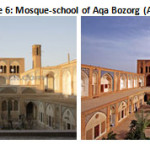 |
|
In this regard, another example of Iranian architecture could clarify this point. DolatAbaad Garden is another kind of this attitude to realize peaceful coexistence of man and environment that reflects the architecture of this building which is different in using natural forces. Iranian thought on the construction of the building showed his deep understanding of the technical and ecological issues. The technology to build its wind towers up to a height of 34 meters is remarkable. Applying the wind force is a kind of indigenous technological knowledge in the use of natural forces to create a favorable environment for numerous (Fig. 7).
![Figure 7: Dolat Abad Garden- section of wind tower [44]](http://www.cwejournal.org/wp-content/uploads/2016/05/Vol11_No2_Inve_Mahm_Fig7-150x150.jpg) |
|
Shafieyoon & Najafpoor 42 expressed "Finding details about background of windward tower, is very difficult. Because there were the tallest structures of buildings and in each building the first signs of damage might be seen in the roof and especially windward tower. The simplest example of the windward tower has been found among the Indians of Peru. They had their homes ventilated by using windward tower. Windward tower by guiding the wind stream and using the natural, clean energy has had an important role in adjustment of temperature and reaching an appropriate temperature in residential places."
They also 42 expressed about windward in Iran "Windward towers of the old towns in these areas (hot and dry or hot and humid) look like vertical channels. And they are considered as the tallest places of the town after the mosques. One of the difficulties of archaeologists is finding an evidence to prove that the windward tower back to Iran before emerging of the Islam. The first historical document about Iranian windward is backed to the fourth millennium before BC. What is important is that the windward towers, the most innovative elements of traditional Iranian architecture, are destroyed gradually. They are durable because of their construction's techniques. Strength of windward is related to the maintenance of them and the way they have been built.
The materials of the buildings are selected according to the climate that they are built in. The windward towers of Yazd are made of cob and clay. Clay can transmit thermal energy fast. Because the earth is non-compact and mild and clay is made of water and earth and after evaporation of its water, some holes are emerged in it. So, heat and cold are prevented from getting into molecules of clay, soil and brick. Windward towers are usually made of adobe, brick, clay, plaster and especial wood which are called "shourouneh". This kind of wood is very strength. It is also resistant to termite attack.
The surface of the tower is covered by cob and its bright color reflects the sun's rays. Cob includes straws which make the surface of tower rough and it causes more reflection and less absorption of solar energy. Despite the fact that there is no need to store heat in hot and humid climates, using brick and clay materials are clearly seen. The reason likely is that these kinds of materials are abundant in this area ecologically".42
UNESCO43 expressed that "Soltaniyeh Dome is situated in the province of Zanjan. Soltaniyeh is one of the outstanding examples of the achievements of Persian architecture and a key monument in the development of its Islamic architecture. The octagonal building is crowned with a 50 m tall dome covered in turquoise-blue faience and surrounded by eight slender minarets. It is the earliest existing example of the double-shelled dome in Iran. Pope has described the building as ‘anticipating the Taj Mahal" (Fig.8)
![Figure 8: Soltaniyeh dome [43]](http://www.cwejournal.org/wp-content/uploads/2016/05/Vol11_No2_Inve_Mahm_Fig8-150x150.jpg) |
|
Findings and Discussion
How is it that nowadays architecture with no single point of view so that to be successful? The reason, in author opinion, is lack of attention to the cultural component of the architecture in different territories. As the dynamics of Islamic and Gothic architecture and failed in the past to various territories without changing their influence. For example, if the element bearing arc technique has been investigated in the past without transposition period, we find that its performance is its bearing, but how to use it from Europe to Iran, India and the Arab countries is different and the due to the effect".44
Persian architecture is an art dealing with people's activities. Iranian architects tend to design the traditional architecture elements with respect to climate and environmental considerations, this trend results in an architecture which is inspired by genius and technical knowledge.45
Persian architecture has different effects on people's life and the goal of designing spaces and elements is to improve the quality of living. This fact describes why architectural elements in old buildings were designed based on climatic and living conditions [46]. Although Iran has various climates, traditional architecture has successfully provided suitable designs for people to live comfortable.44 There are multipurpose elements in Iranian architecture such as wind catchers, courtyard, Orosi and etc. For instance, studying on the light controlling elements such as 'Orosi' in Iranian traditional architecture shows that it works in four ways :climatic function, psychological function, aesthetic function and spiritual and symbolic function.47 Table 2 shows ecologic and cultural functions of some Iranian traditional architecture elements and their manufacturing technologies.
Traditional Iranian buildings have been designed to provide the most possible comfort without the aid of mechanical equipments.48 Engineering and technology in Iran is closely connected with science, art, philosophy and religion (and culture).49 In this regard, wind catchers are one of the greatest architecturally engineering achievements in Iran.
Today, the rate of fossil fuel consumption has surged due to increasing population growth of the world. For this reason, one of the urgent needs of today's modern world seems to be finding ways to decrease or at least optimize fossil fuel consumption. In the past, traditional intelligent architects tried to create a human-based architecture so that they could provide the best possible comfort for people with minimum available possibilities. Today, notwithstanding, it is still possible to save energy consumption and consequent costs considerably through updating traditional approaches.
Iranian traditional architectural approach to the nature of the verse is, in fact, approach and attitude compatible with the nature of the circuit, but the doctrine ECOTECHNOLOGY maximize the efficient use of technology with an emphasis on ecological and environmental approach to a few decades ago. Thus, the architecture of the different technologies in the fields of construction, environment and development of music in itself and always had a foundation in the school building so, Agha Bozorg Mosque technology more advanced than its predecessor buildings of it is in this respect. Therefore, we find that the issue of technology and ecology that today it is not a new problem ECOTECHNOLOGY interpreted in the architecture and the architecture of it is in itself.
The sustainable architecture that advances to a point in order to be allowed to reach its aims and goals deems necessary the design off any building with the least adverse effect on environment as well as design consistent with nature. Thus by considering the traditional Iranian architecture, it is observed that Iranian architectural characteristics conform to the rules of sustainable architecture; and can obtain sustainability in modern architecture by being reveled by certain features of traditional Iranian one.
How and to what extent usage of high technology in harmony with the natural environment hasn’t been similar or not going to be similar in all types of buildings, in some important monuments of architecture and urbanism, sometimes latest technical innovations are used. It seems that using this kind of methods is impossible for developing countries. But the experiences of European countries in some areas, especially in the case of some small buildings such as residential units would be very helpful. Some architecture in order to establish connection and coordination between human and natural environment try to use natural material and indigenous methods. And try to find out about the characterization of traditional materials. Old valuable methods can be carried on in modern times by using indigenous architecture, which is the result of the acceptance of criteria of popular architecture.50
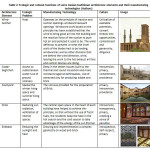 |
|
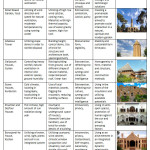 |
|
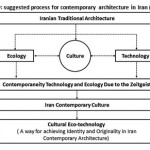 |
|
Conclusion
In this article, we talked about today architectural concepts "Stability" which is consist of ecological and technologic issues. We also found out that today's architecture will not survive without these two concepts. These global concepts should be adapted to a country's cultural and local situations to be usable there. For such adaptation, we have to study them in the past architecture, and our past architecture answers this subject so good. But using these concepts by just "copying" is not useful and requires to be changed regarding the time's spirit.
The definition of "stable development" is made by the ideology of each civilization which should be in mind in preparing main principles of the social activities. The vision of Iranian ancient architecture is ultra-systemic, which is a cultural thing and has an eco-cultural basis. Eco-Tech vision is pure scientific according to update knowledge and technology but Iranian ancient architecture is scientific-cultural according to the knowledge and technology of its own era. Eco-tech is literary a reverse to the past based on today science and technology.
As science is borderless but culture has borders, being far from science's world will results in a deep gap in the politics, cultural, social and economic future of our country. So, using global experiences is essential in the field of science and technology.
The producers of Iranian past architecture believe that making a perfect environment for human being lives is essential. They used patterns and principles which is not hazardous to the nature at all. Furthermore, they use science to flourish human cultural and spiritual growth. Assessing Iranian architecture history demonstrates its constant development and growth. We can observe that architecture in "Saljughian" has been more progressed than "Sasanian" era. This developed idea has been in Iranians' culture.
So not only we should not be against eco-tech ideas, but also we should appreciate and analyze it to use in today's architecture. In fact, eco-tech should be mixed with cultural stuffs and make a country specific pattern which is the subject authors are trying to extend and recommend to the authorities to use in buildings (Fig.9).
References
- World Commission on Environment and Development. "Our Common Future". Oxford University Press, Oxford, United States (1987).
- Horlings, LG. "The inner dimension of sustainability: personal and cultural values". Current Opinion in Environmental Sustainability, 14: 163–169 (2015).
CrossRef - Straskraba, M. "Ecotechnology as a new means for environmental management". Ecological Engineering, 2(4): 311-331 (1993).
CrossRef - Mitchell, D. "There is no such thing as culture: towards reconceptualization of the idea of culture in geography". Transactions of the Institute of British Geographers, 20:102-116 (1994).
CrossRef - Duxbury, N., Jeanotte, S. "Culture, Sustainability, and Communities: Exploring the Myths". Coimbra, Portugal: Centro de Estudos Socias Laboratorio Associado, Faculdade de Economia Universidade de Coimbra (2010).
- Soini, K., Birkeland, I. "Exploring the scientific discourse on cultural sustainability", Geoforum, 51: 213–223 (2014).
CrossRef - Connelly, S. "Mapping sustainable development as a contested concept". Local Environment, 12(3):259–278 (2007).
CrossRef - Black, A. "Pillars, bottom lines, capitals and sustainability: a critical review of the discourses". International Journal of Environmental, Cultural, Economic and Social Sustainability, 2(5):107–117 (2007).
CrossRef - Steele, J. "Ecological Architecture; A Critical History". Thames & Hudson, London, UK (2005).
- Boström, M. "A missing pillar? Challenges in theorizing and practicing social sustainability: introduction to the special issue". Sustainability: Science, Practice & Policy, 8(12):3-14 (2012).
CrossRef - N., Lourenco J.M., & Nunes da Silva, F. "Sustainable development policy: goals, targets and political cycles". Sustainable Development, 19:15-29 (2011).
CrossRef - De Vries, B., Petersen A.C. "Conceptualizing sustainable development; An assessment methodology connecting values, knowledge, worldviews and scenarios". Ecological Economocs, 68: 1006-1019 (2009).
CrossRef - Rajeswar, J. "Deconstructing the development paradigm: a post-structural perspective". Sustainable Development, 18: 245-251 (2010).
CrossRef - Hay, R. "The relevance of ecocentrism, personal development and transformational leadership to sustainability and identity".Sustainable Development, 18: 163-171 (2010).
CrossRef - Mirrazavi, F. "Iranian Architecture". (2009), http://www.iranreview.org/content/Documents/Iranian_Architecture.htm
- Ahmadkhani Maleki, B. "Traditional Sustainable Solutions in Iranian Desert Architecture to Solve the Energy Problem", International Journal on Technical and Physical Problems of Engineering (IJTPE), 3(1):84-91 (2011).
- Shahamat, H. " Formal Sustainability in Traditional Architecture of Iran According To Five Principles of Traditional Architecture of Iran". Journal of Applied Environmental and Biological Sciences, 4(1): 100-110 (2014).
- Assari, A., Mahesh, TM. , Emtehani, MR., Assari, E. "Comparative Sustainability of Bazaar in Iranian Traditional Cities: Case Studies in Isfahan and Tabriz". International Journal on Technical and Physical Problems of Engineering (IJTPE), 9, 3(4):18-24 (2011).
- Assari, A., Mahesh, TM. "Demographic Comparative in Heritage Texture of Isfahan City". Journal of Geography and Regional Planning, 4(8):463-70 (2011).
- Assari, A., Mahesh, TM., Assari, E. "Conservation of Historic Urban Core in Traditional Islamic Culture: Case Study of Isfahan City". Indian Journal of Science and Technology, 5(1):1970-1976 (2012).
- Assai, A., Assari, E. "Urban Spirit and Heritage Conservation Problems: Case Study Isfahan City in Iran". Journal of American Science, 8(1):202-109 (2012).
- Slessor, C., Linden, J. "Eco-tech: Sustainable Architecture and High Technology". Thames & Hudson, London, UK (2001).
- Leach, N. "Rethinking Architecture: A Reader in Cultural Theory". Psychology Press, UK, (1997).
- Dryzek, J.S. "The Politics of the Earth; Environmental Discourses", Oxford University Press, United States (2013).
- World Commission on Culture and Development. "Our Creative Diversity". EGOPRIM, France (1995).
- Agenda 21 for culture. "Culture and Sustainable Development: Examples of Institutional Innovation and Proposal of a New Cultural Policy Profile". (2009). .
- Chiu, R. "Socio-cultural sustainability of housing: a conceptual exploration". Housing Theory Soc., Vol. 21, No. 2, pp. 65-76 (2004).
CrossRef - Throsby, D. "Linking ecological and cultural sustainability". International journal of diversity in organisations, 8(1):15-20 (2008).
- Hawkes, J. "The Fourth Pillar of Sustainability: Culture’s Essential Role in Public Planning". Common Ground P/L, Melbourne, Australia (2001).
- Birkeland, I. "Cultural sustainability: industrialism, placelessness and the reanimation of place". Ethics, Place & Environment, 11(3):283–297 (2008).
CrossRef - Short, G. "Sustainability of Material Culture in the Post-Modern". International Journal of Environmental, Cultural, Economic and Social Sustainability, 1(4): 1-8 (2005).
- Gerhardinger, L.C., Godoy, E.A.S., & Jones, P.J.S. "Local ecological knowledge and the management of marine protected areas in Brazil". Ocean Coast. Manage, 52: 154-165 (2009).
CrossRef - Costa-Neto, E.M. "Sustainable development and traditional knowledge: a case study in a Brazilian artisanal Fishermen’s Community". Sustainable Development. 8(2):89-95 (2000).
CrossRef - Terranova, A., Spirito, G., Leone, S., & Spita, L. "Eco structures: Forms of Sustainable Architecture". White Star Publishers, Italy (2009).
- Roth, L.M. "Understanding Architecture: It's Elements, History and Meaning". The Herbert Press Ltd., London, UK (1994).
- Steele, J., Badran, R. "The Architecture of Rasem Badran: Narratives on People and Place". Thames & Hudson, London, UK (2005).
- Bonnie Massoud, A. "Iranian contemporary architecture (the struggle between tradition and modernity)". Publication century architecture, Tehran, Iran (2009).
- Cal-Earth Institute & Hesperia. "Sandbag Shelter Prototypes Various locations worldwide". The Aga Khan Award for Architecture, United States (2004).
- Al-Asad, M. "Contemporary Architecture and Urbanism in the Middle East". University Press of Florida, Gainesville, United States, 2012.
- Pirnia, M. " Iranian Architecture Stylistics". Saadi, Tehran, iran (2005).
- Serageldin, I., Steele, J. "Architecture of the contemporary mosque". Academy Editions, Original from the University of Michigan, United States (1996).
- Shafieyoon, H., Najafpoor, D. "Ecotech: An Old Style in Iran’s Architecture". International Congress on Sustainability in Architecture and Urbanism, Masdar city (2015).
- UNESCO, World Heritage Center Website (2016): http://whc.unesco.org
- Ghobadian, V. "Climatic Study of Persian Traditional Buildings". Tehran University Publication, Tehran, Iran (2008).
- Valibeigi, N., Nasekhian, S., & Tavakoli, S. "The Role of Wind catchers in Improving People's Comfort". Eco-Architecture V: Harmonisation between Architecture and Nature, 142: 93-102 (2014).
- Memarian, Gh. "Persian Architecture". Soroush-e-Danesh Publication, Tehran, Iran (2002).
- Ahani, F. "Natural Light in Traditional Architecture of Iran: lessons to remember". Light in Engineering, Architecture and the Environment. 121: 25-36, 2011.
CrossRef - Akrami, GH., Vaez Maroufi, M. "Climatic design; The house pattern in Khour village". Memari Quartery, 17(3):50-61, 2008.
- Farshad, M. "The History of Engineering in Iran". Balkh Publication, Tehran, Iran (1997).
- Sayad, E. & Madahi, M. "Sustainable architecture". Lutz publication, Tehran, Iran (2011).







